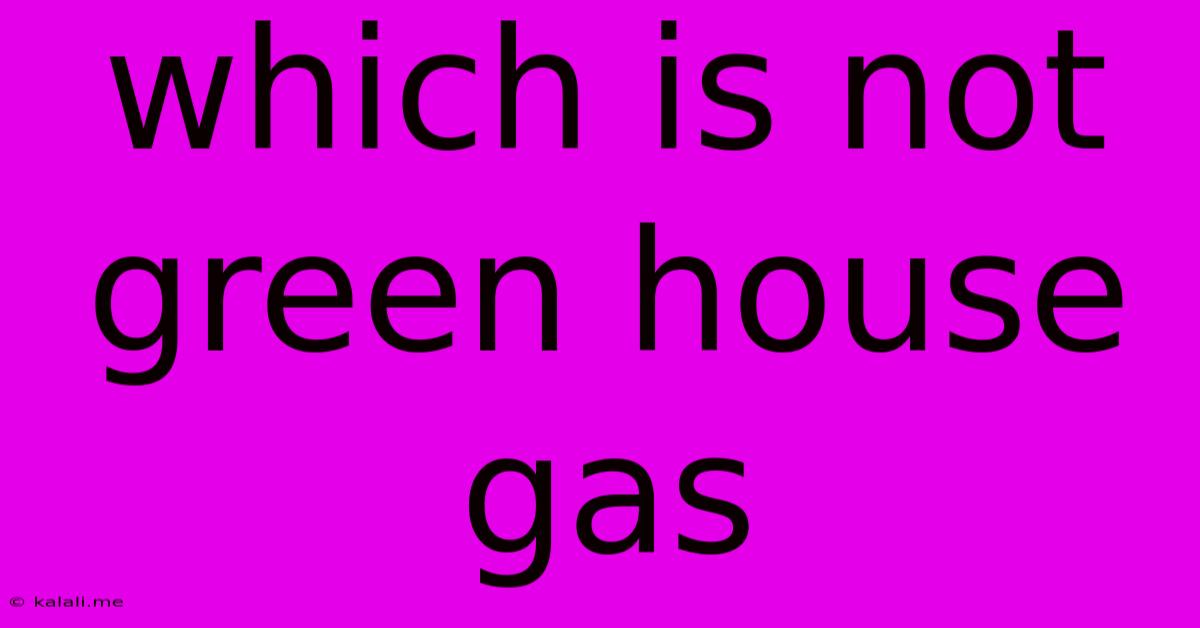Which Is Not Green House Gas
Kalali
Jun 12, 2025 · 2 min read

Table of Contents
Which is Not a Greenhouse Gas? Understanding the Atmospheric Composition
Greenhouse gases are vital components of our atmosphere, trapping heat and regulating Earth's temperature. However, an excess of these gases leads to global warming and climate change. Understanding which gases contribute to this effect, and which don't, is crucial for addressing environmental concerns. This article will explore various atmospheric components and identify those that are not considered greenhouse gases.
What are Greenhouse Gases? Before identifying the non-greenhouse gases, let's briefly review the key players. Greenhouse gases absorb and re-emit infrared radiation, trapping heat within the atmosphere. The most prominent examples include carbon dioxide (CO2), methane (CH4), nitrous oxide (N2O), and fluorinated gases (like CFCs and HFCs). These gases have specific molecular structures that allow them to interact with infrared radiation effectively.
Gases that Don't Contribute to the Greenhouse Effect: Several atmospheric components do not possess the molecular properties necessary to absorb and re-emit infrared radiation in the same way greenhouse gases do. Therefore, they don't significantly contribute to the greenhouse effect. These include:
-
Oxygen (O2): This vital gas makes up about 21% of Earth's atmosphere and is essential for respiration. However, its symmetrical molecular structure prevents it from effectively interacting with infrared radiation. Therefore, oxygen is not a greenhouse gas.
-
Nitrogen (N2): Nitrogen constitutes approximately 78% of the Earth's atmosphere and is a major component of the air we breathe. Similar to oxygen, its symmetrical molecular structure means it doesn't absorb infrared radiation efficiently. Consequently, nitrogen is not considered a greenhouse gas.
-
Argon (Ar): Argon is a noble gas and a relatively abundant component of the atmosphere. Its atomic structure prevents it from interacting with infrared radiation, thereby making it a non-greenhouse gas.
-
Neon (Ne), Helium (He), Krypton (Kr), Xenon (Xe): These are all noble gases, and like argon, their atomic structures prevent them from absorbing and re-emitting infrared radiation. They play a minimal role in the greenhouse effect.
The Importance of Atmospheric Composition: The relative abundance of various gases in the atmosphere is crucial for maintaining a stable climate. While gases like oxygen and nitrogen are not greenhouse gases, they are vital for life on Earth. Understanding the roles of each atmospheric component helps in developing effective strategies to mitigate climate change by focusing on reducing emissions of actual greenhouse gases.
Conclusion: While many gases contribute to the Earth's atmosphere, not all of them are greenhouse gases. Oxygen, nitrogen, argon, and other noble gases do not possess the molecular properties to trap heat, unlike CO2, methane, and other known greenhouse gases. Understanding this distinction is paramount in addressing climate change and promoting environmental sustainability. Focusing our efforts on reducing emissions of genuine greenhouse gases is crucial for mitigating the effects of global warming.
Latest Posts
Latest Posts
-
What Is The Factors Of 144
Jun 13, 2025
-
If X 0 Then X Is Equal To
Jun 13, 2025
-
Lcm Of 4 6 And 10
Jun 13, 2025
-
What Is The Multiples Of 60
Jun 13, 2025
-
How Does Mitosis In Plant And Animal Cells Differ
Jun 13, 2025
Related Post
Thank you for visiting our website which covers about Which Is Not Green House Gas . We hope the information provided has been useful to you. Feel free to contact us if you have any questions or need further assistance. See you next time and don't miss to bookmark.